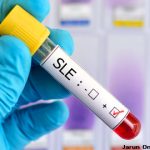‘We have identified genetic associations that may account for more than 50% of the heritable risk of lupus among patients of European-American descent.’ —Dr. James
They found the interferon gene signature was present in 85% of the pediatric lupus patient samples, but in only 15% of samples from healthy children. They also identified 486 transcripts that were most correlated with disease activity, as well as a neutrophil gene signature strongly linked with lupus nephritis.
At Dr. James’ center, researchers have been looking at adult lupus, attempting to use clinical features, gene expression profiling, soluble mediators, autoantibodies and immunophenotyping to try to split patients into subgroups that will characterize them more specifically compared to the general lupus population. Among their findings, patients who were early to flare had elevated CD11b(high) monocytes and elevated CD86(high) B cells, and one group featured more kidney disease than other groups.
Dr. James said some of the same clinical features were seen in different molecular subgroups. “That may suggest that patients get to the same clinical phenotype but through different molecular pathways, which may be important [because] we’re trying to select the right medication for the right patient,” she said.
Despite the progress in trying to treat at the individual patient level, some improvements are needed in rheumatology to take the next steps. “We need more systems biology … approaches to take all of this collective information and distill it into things we can use practically for an individual patient on a given day,” she said.
More effective collaborations are needed as well, Dr. James continued. “And we’re going to need different types of interaction with different kinds of health professionals who we haven’t historically used in rheumatology, like molecular pathologists, who are really focused on the genetic information.”
She mentioned many “huge” precision medicine programs are underway—e.g., the National Institutes of Medicine All of Us Precision Medicine Initiative and the Million Veteran Program—that plan to enroll a million Americans for whole genome sequencing.
“You will see more and more patients [with] the sequencing data.”
Thomas R. Collins is a freelance writer living in South Florida.
References
- Langefeld CD, Ainsworth HC, Cunninghame Graham DS, et al. Transancestral mapping and genetic load in systemic lupus erythematosus. Nat Commun. 2017 Jul 17;8:16021.
- Banchereau R, Hong S, Cantarel B, et al. Personalized immunomonitoring uncovers molecular networks that stratify lupus patients. Cell. 2016 Apr 21;165(3):551–565.


